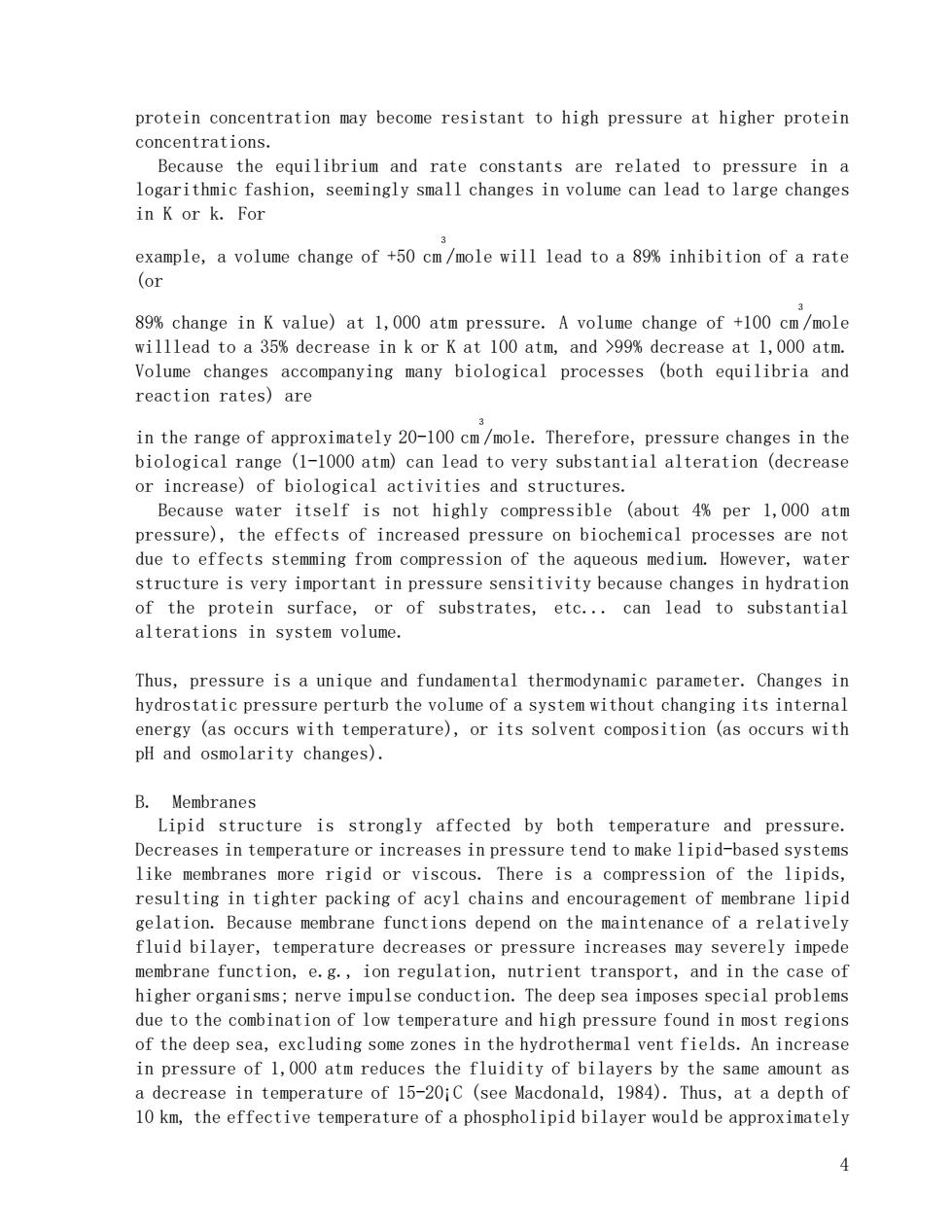正在加载图片...

protein concentration may become resistant to high pressure at higher protein concentrations. Because the equilibrium and rate constants are related to pressure in a logarithmic fashion,seemingly small changes in volume can lead to large changes in K or k.For example,a volume change of +50 cm/mole will lead to a 89%inhibition of a rate (or 89%change in K value)at 1,000 atm pressure.A volume change of +100 cm/mole willlead to a 35%decrease in k or K at 100 atm,and >99%decrease at 1,000 atm. Volume changes accompanying many biological processes (both equilibria and reaction rates)are 3 in the range of approximately 20-100 cm/mole.Therefore,pressure changes in the biological range (1-1000 atm)can lead to very substantial alteration (decrease or increase)of biological activities and structures. Because water itself is not highly compressible (about 4%per 1,000 atm pressure),the effects of increased pressure on biochemical processes are not due to effects stemming from compression of the aqueous medium.However,water structure is very important in pressure sensitivity because changes in hydration of the protein surface,or of substrates,etc...can lead to substantial alterations in system volume. Thus,pressure is a unique and fundamental thermodynamic parameter.Changes in hydrostatic pressure perturb the volume of a system without changing its internal energy (as occurs with temperature),or its solvent composition (as occurs with pH and osmolarity changes). B.Membranes Lipid structure is strongly affected by both temperature and pressure. Decreases in temperature or increases in pressure tend to make lipid-based systems like membranes more rigid or viscous.There is a compression of the lipids, resulting in tighter packing of acyl chains and encouragement of membrane lipid gelation.Because membrane functions depend on the maintenance of a relatively fluid bilayer,temperature decreases or pressure increases may severely impede membrane function,e.g.,ion regulation,nutrient transport,and in the case of higher organisms;nerve impulse conduction.The deep sea imposes special problems due to the combination of low temperature and high pressure found in most regions of the deep sea,excluding some zones in the hydrothermal vent fields.An increase in pressure of 1,000 atm reduces the fluidity of bilayers by the same amount as a decrease in temperature of 15-20iC (see Macdonald,1984).Thus,at a depth of 10 km,the effective temperature of a phospholipid bilayer would be approximately 44 protein concentration may become resistant to high pressure at higher protein concentrations. Because the equilibrium and rate constants are related to pressure in a logarithmic fashion, seemingly small changes in volume can lead to large changes in K or k. For example, a volume change of +50 cm 3/mole will lead to a 89% inhibition of a rate (or 89% change in K value) at 1,000 atm pressure. A volume change of +100 cm 3/mole willlead to a 35% decrease in k or K at 100 atm, and >99% decrease at 1,000 atm. Volume changes accompanying many biological processes (both equilibria and reaction rates) are in the range of approximately 20-100 cm 3/mole. Therefore, pressure changes in the biological range (1-1000 atm) can lead to very substantial alteration (decrease or increase) of biological activities and structures. Because water itself is not highly compressible (about 4% per 1,000 atm pressure), the effects of increased pressure on biochemical processes are not due to effects stemming from compression of the aqueous medium. However, water structure is very important in pressure sensitivity because changes in hydration of the protein surface, or of substrates, etc... can lead to substantial alterations in system volume. Thus, pressure is a unique and fundamental thermodynamic parameter. Changes in hydrostatic pressure perturb the volume of a system without changing its internal energy (as occurs with temperature), or its solvent composition (as occurs with pH and osmolarity changes). B. Membranes Lipid structure is strongly affected by both temperature and pressure. Decreases in temperature or increases in pressure tend to make lipid-based systems like membranes more rigid or viscous. There is a compression of the lipids, resulting in tighter packing of acyl chains and encouragement of membrane lipid gelation. Because membrane functions depend on the maintenance of a relatively fluid bilayer, temperature decreases or pressure increases may severely impede membrane function, e.g., ion regulation, nutrient transport, and in the case of higher organisms; nerve impulse conduction. The deep sea imposes special problems due to the combination of low temperature and high pressure found in most regions of the deep sea, excluding some zones in the hydrothermal vent fields. An increase in pressure of 1,000 atm reduces the fluidity of bilayers by the same amount as a decrease in temperature of 15-20¡C (see Macdonald, 1984). Thus, at a depth of 10 km, the effective temperature of a phospholipid bilayer would be approximately